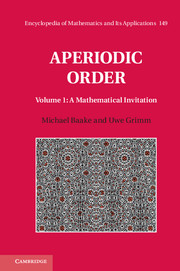Book contents
- Frontmatter
- Contents
- Foreword
- Preface
- Chapter 1 Introduction
- Chapter 2 Preliminaries
- Chapter 3 Lattices and Crystals
- Chapter 4 Symbolic Substitutions and Inflations
- Chapter 5 Patterns and Tilings
- Chapter 6 Inflation Tilings
- Chapter 7 Projection Method and Model Sets
- Chapter 8 Fourier Analysis and Measures
- Chapter 9 Diffraction
- Chapter 10 Beyond Model Sets
- Chapter 11 Random Structures
- Appendix A The Icosahedral Group
- Appendix B The Dynamical Spectrum
- References
- List of Examples
- List of Remarks
- Index
Chapter 6 - Inflation Tilings
Published online by Cambridge University Press: 18 December 2014
- Frontmatter
- Contents
- Foreword
- Preface
- Chapter 1 Introduction
- Chapter 2 Preliminaries
- Chapter 3 Lattices and Crystals
- Chapter 4 Symbolic Substitutions and Inflations
- Chapter 5 Patterns and Tilings
- Chapter 6 Inflation Tilings
- Chapter 7 Projection Method and Model Sets
- Chapter 8 Fourier Analysis and Measures
- Chapter 9 Diffraction
- Chapter 10 Beyond Model Sets
- Chapter 11 Random Structures
- Appendix A The Icosahedral Group
- Appendix B The Dynamical Spectrum
- References
- List of Examples
- List of Remarks
- Index
Summary
Having introduced some general geometric concepts in Chapter 5, we will now discuss inflation tilings in more detail, mainly by way of (planar) examples; see [HFonl] for further cases. Various illustrative colour figures are collected at the end of this chapter. Our setting employs the generalisation of the geometric inflation rules of Chapter 4 to higher dimensions, as developed in Chapter 5. In particular, we again define hulls via fixed points of the geometric inflation and their translation orbit closures. Here, we usually employ the continuous hull as obtained from the translation action of ℝd. We explain and further develop the concepts of repetitivity, minimality, ergodicity and aperiodicity as we go along. As intimately related (FLC) tilings may look rather different at first sight, an important point will be the systematic application of the equivalence concept of mutual local derivability (MLD).
Ammann–Beenker tilings
One of the simplest planar aperiodic tilings is the octagonal or Ammann–Beenker tiling from Figure 1.5 on page 7. It is built, up to orientation, from two prototiles, a square and a rhombus with opening angle Π/4, both of edge length 1. A simple stone inflation rule can be constructed from the original approach [GS87, AGS 92] by cutting the square along one diagonal into two isosceles triangles. An algebraic approach was independently developed in [Bee82], and will later be discussed in the projection context.
- Type
- Chapter
- Information
- Aperiodic Order , pp. 175 - 250Publisher: Cambridge University PressPrint publication year: 2013

